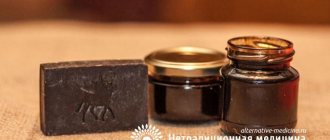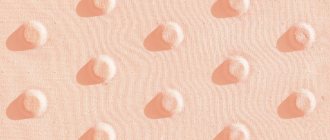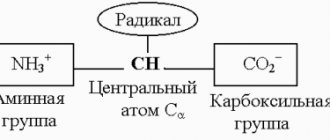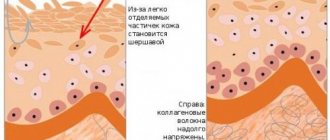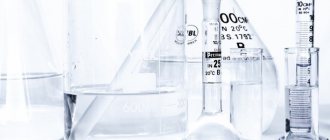Home / Acids / Boric acid - H3BO3
%D %d.%M.%y %h~:~%m
Boric acid (orthoboric acid) is a weak acid with the chemical formula H3BO3.
flat layer structure in orthoboric acid
A colorless, odorless, crystalline substance in the form of flakes, it has a layered triclinic lattice in which acid molecules are connected by hydrogen bonds into flat layers, the layers are connected to each other by intermolecular bonds (d = 0.318 nm).
Metaboric acid (HBO2) also appears as colorless crystals. It exists in three modifications - the most stable γ-HBO2 with a cubic lattice, β-HBO2 with a monoclinic lattice, and α-HBO2 with an orthorhombic lattice.
When heated, orthoboric acid loses water and first transforms into metaboric acid, then into tetraboric acid H2B4O7. With further heating it dehydrates to boric anhydride.
Aqueous solutions of boric acid are a mixture of polyboric acids with the general formula H3m-2nBmO3m-n.
Properties
Boric acid exhibits very weak acidic properties. It is relatively slightly soluble in water. Its acidic properties are due not to the abstraction of the H+ proton, but to the addition of a hydroxyl anion:
Ka = 5.8·10−10 mol/l; pKa = 9.24.
It is easily displaced from solutions of its salts by most other acids. Its salts, called borates, are usually produced from various polyboric acids, most often tetraboric acid H2B4O7, which is a much stronger acid than orthoboric acid. B(OH)3 shows very weak signs of amphotericity, forming low-stable boron hydrogen sulfate B(HSO4)3.
When orthoboric acid is neutralized with alkalis in aqueous solutions, orthoborates containing the (BO3)3− ion are not formed, since orthoborates are hydrolyzed almost completely due to the too low formation constant [B(OH)4]−. Tetraborates, metaborates or salts of other polyboric acids are formed in solution:
With an excess of alkali they can be converted into metaborates:
Meta- and tetraborates are hydrolyzed, but to a lesser extent (reactions opposite to those given).
In acidified aqueous solutions of borates, the following equilibria are established:
The most common salt of boric acid is sodium tetraborate decahydrate Na2B4O7 10H2O (technical name borax).
When heated, boric acid dissolves metal oxides, forming salts.
With alcohols in the presence of concentrated sulfuric acid it forms esters:
The formation of boron methyl ether B(OCH3)3 is a qualitative reaction to H3BO3 and boric acid salts; when ignited, boron methyl ether burns with a beautiful bright green flame.
Boric acid
Home Articles Boric acid
Boric acid was obtained by the German naturalist Wilhelm Homberg in 1702 by treating the mineral borax with inorganic acids, such as hydrochloric acid. It is found in hot and mineral springs, sea water, and in the form of the mineral sassolite in areas of volcanic activity. Also known as orthoboric acid or hydrogen borate. Boric acid was registered as an insecticide in 1948 in the USA.
Orthoboric acid - H3BO3 - transparent layered crystals in which the molecules are tightly linked by hydrogen bonds, or white crystalline powder; has no taste or smell. Solubility in water at 20 °C 49.5 g/l, at 100 °C – 391 g/l, in alcohol – 90 g/l; It dissolves well, but slowly, in glycerin, and is practically insoluble in ether and gasoline.
When heated to 170 °C, H3BO3 melts, partially loses water and forms metaboric acid HBO2, at 300 °C - tetraboric acid H2B4O7, which at 330 °C decomposes into water and boric anhydride B2O3. Metaboric and tetraboric acids dissolved in water are converted back to orthoboric acid. All three acids are sometimes present in aqueous solutions. Under normal conditions, boric acid is stable, but hygroscopic - it absorbs moisture well.
The evaporation of boric acid at 20° C is insignificant, however, in powder form it quickly reaches dangerous concentrations in the air. Dissolved in water or alcohol, volatile with solvent vapors. Reactions with metals when heated release hydrogen, which creates a risk of fire and explosion.
Boric acid is stored in a hermetically sealed container, taking into account:
- incompatibility with strong bases, ammonia, alkali metal carbonates, strong oxidizing agents;
- dangers of dust formation;
- the destructive influence of excess temperatures;
- unwanted exposure to moisture and air.
Action
Boron preparations have a contact-intestinal effect. Insects receive the insecticide as part of food baits and through the chitinous cover, damaged by adherent powder crystals. Death begins on the 5-10th day of use. Boric acid is more effective than its salts - sodium tetraborate (borax) and disodium octaborate tetrahydrate.
The trace element boron and its compounds are general cellular poisons; they coagulate proteins and disrupt the permeability of the cell membrane. In the insect's body, boric acid damages the walls of the foregut, fills the stomach, and causes dehydration. Boric acid and borax lead to sterilization of insects with prolonged consumption.
It should be noted the phenomenon of secondary transfer, characteristic of boric acid-based products. In cockroaches, it manifests itself in coprophagy—the larvae eat excrement, leading to poisoning. The first instar larvae die completely in 10 days, half of the second instar larvae die in 14 days. One of the reasons for its effectiveness against ants is that they manage to bring poison into the nest, poisoning other insects.
Boric acid insecticides
Application
Boric acid is used:
- in swimming pools to reduce the concentration of chlorine, purify water from fungus and algae;
- to protect wood from mold;
- in medicine as an antiseptic;
- in agriculture as a microfertilizer;
- as an insecticidal agent against cockroaches, ants, termites, silverfish, fleas and ticks.
In the United States, more than 500 insecticidal preparations containing boric acid from 40 to 98% are sold in the form of liquids, wettable powders, dusts, tablets, granules, and ready-made baits. They are used in residential buildings, hospitals, commercial buildings, and food processing plants.
The 2009 Medical Pest Control Guide recommends the use of boric acid and borax to prepare baits and as a stabilizer in dusts. The food base of the bait is boiled potatoes, eggs, semolina porridge, minced meat, 10% sugar syrup with pieces of bread. Baits are used when insects do not have alternative food.
Liquid baits are several times more effective than dry baits; they cause the death of 90% of cockroaches within 2-3 days. Perhaps they are more attractive. Some researchers have reported the repellent effect of borates in dry baits.
According to the classification of the Committee on Insecticide Resistance of Arthropods, borates are classified as multiple nonspecific inhibitors. In drug rotation schemes, they can follow any organic insecticides. Resistance to boric acid and its salts was not observed. These substances are even used against multi-resistant cockroach populations.
Toxicity
The substance enters the body by inhalation, ingestion, through damaged skin and mucous membranes. With repeated administrations it can accumulate in organs and tissues. It is excreted slowly, in 12 hours the kidneys excrete about half, the rest in 5-7 days.
If boric acid is ingested, vomiting, abdominal pain, diarrhea, skin rash, drowsiness, and headache occur. Inhalation causes cough, sore throat, shortness of breath, and nosebleeds. Long-term intake of large doses disrupts the functioning of the kidneys and liver, reduces the number of red blood cells, and causes convulsions; rarely in severe cases the person falls into a coma and dies. The minimum lethal dose is 5-20 g/kg, for infants 2-3 g/kg.
Chronic absorption of non-toxic doses of boric acid affects hematopoietic and germ cells. The substance is toxic to the embryo and can cause deformities and defects of the heart, skeleton, kidneys and lungs. Carcinogenic properties were not revealed in two-year animal experiments.
Boric acid is a moderately hazardous substance - hazard class 3, LD50 for a rat when administered into the stomach is 2660 mg/kg; preparations based on it are slightly dangerous - hazard class 4.
The substance does not pose a threat to the environment, as it is naturally present in it. It does not emit vapors into the atmosphere; Particles released into the air settle on the ground, enter the water, and are absorbed by plants. Boric acid is practically non-toxic for birds, fish, and amphibians, and relatively non-toxic for bees.
Application
- In nuclear reactors as a neutron absorber dissolved in the coolant.
- Boron fertilizer
- Used in laboratories to prepare buffer solutions
- In medicine - as an independent disinfectant, and also in the form of a 2% solution - for washing the skin after contact with alkalis
- Also, various combination preparations are produced based on boric acid (ATC group D08AD), for example, Teymurov’s paste.
- In photography - as part of fine-grained developers and acidic fixers to create a weak acidic environment.
- In the food industry, it is registered as food additive E284 (in Russia, this additive is not included in the list of approved products [1]).
- In the Novus game, the gaming table is rubbed with boric acid to make the chips slide better.
- In jewelry - as the basis of fluxes for soldering gold-containing alloys.
- In industry - a binder for acid lining of furnaces.
Use in the garden
The use of boric acid in the garden is quite varied. What can be done? Spray or water beds with fruit and berry crops, or treat the habitats of insect pests to get rid of them.
Feeding with boric acid
Water the beds with liquid boric acid. Each plant has its own need for boron; accordingly, they need to be fertilized differently.
The drug solution is applied in two ways: root and foliar.
In the first case, the plants need to be watered after moistening the soil. In the second, spray on the leaves and stems, through which the boron will reach all parts of the plant.
Subtleties of application
For boric acid to work, you need to use it correctly. Cockroaches are cunning and tenacious insects that require a serious approach. Many years of experience of housewives allows us to highlight seven significant points in the fight against “uninvited guests.”
- Maintain perfect cleanliness. Before you start a war with cockroaches, you need to do a thorough cleaning of your apartment. Wash all visible surfaces and hard-to-reach places (behind cabinets, under furniture, etc.).
- Eliminate other foods. In order for the poison to be noticed and eaten, the insects must have no other food. Close the trash can tightly, put all food in plastic bags and in the refrigerator.
- Remove the water. If cockroaches have free access to clean water, boric acid may not work. It will be washed out of the insect's body. You need to wipe the bathtub, sinks, pipes dry, and keep the toilet lid closed. Hide wet sponges and rags in plastic bags. Also, remove indoor flowers from their usual place or limit watering for a while.
- Find the right place. The peak activity of cockroaches occurs at night. To figure out where the insects are hiding, enter the room where they were spotted at night and turn on the light. Watch where the cockroaches will run - these are their hiding places, next to which you need to lay out the poison.
- Get attention. Cockroaches are inquisitive creatures. To increase the likelihood of an insect coming into contact with the trap, try to make it bright or place it on a piece of colored cardboard.
- Don't relax. Even if cockroaches have not been seen for several days, this is not a reason to relax.
- Update your traps. Ball traps need to be changed at intervals of one to two days. A cockroach will not eat dried bait.
Signs of boron deficiency on plants and main feedings
With a lack of boron, the roots are inhibited and sometimes rot, the plant’s conducting system develops poorly, the supply of nutrients is difficult, and the plant lags behind in development. Lack of boron stimulates the development of diseases - dry rot, brown rot, hollowness, bacteriosis. With boron deficiency, the growth point may die, and plant pollen is sometimes unable to germinate. The lack of boron is especially noticeable in dry years. And the amateur gardener, often complaining about the meager harvest, does not understand that the reason is a lack of boron. Apple trees especially require a lot of boron.
Boron deficiency may be manifested by changes in leaf color
Boric acid for strawberries
Signs of boron deficiency in garden strawberries: curvature of leaves and necrosis of the edges. Fertilizing with boric acid significantly increases the yield and improves the taste of the berries. In early spring, plantings are watered with a solution of boric acid with the addition of potassium permanganate (1 g potassium permanganate, 1 g boric acid per 10 liters of water), consumption - approximately 10 liters per 30-40 bushes. It is useful to carry out foliar feeding with a solution of boric acid (5 g per 10 liters of water).
Application of boric acid significantly increases strawberry yield
Before flowering, when the plants have put out their buds, apply foliar feeding with a solution (2 g of boric acid, 2 g of manganese, 1 cup of sifted ash per 10 liters of water). Make an extract from the ash in advance: pour a glass of ash with a liter of boiling water and leave, stirring occasionally, for a day, then filter through cheesecloth - and the infusion is ready.
How to get a good harvest of strawberries (garden strawberries).
Boric acid for apple and pear trees
Signs of boron deficiency in apple and pear trees: leaves thicken, warp, suberization and darkening of the veins occurs; during acute starvation, the leaves fall off. Rosette leaves are observed - small leaves at the ends of the shoots are collected in the form of a rosette. In advanced cases, the tree tops die off.
In pear, rosette leaves are characterized by rapid drying of flowers and deformation of fruits, on the surface of which pits and areas of damaged tissue appear.
Boron deficiency may cause apples to become suberized
For apple trees, boron deficiency results in a disease called internal apple suberization. Light spots about 1 cm in diameter appear in the pulp; later they turn brown and become like a cork or sponge. Dry spotting and crusty spots affect the surface of the fruit, which becomes swollen and deformed.
Foliar feeding (10–20 g of boric acid per 10 liters of water) sharply increases fruit formation. It is held in the evening, before sunset. Spray evenly the entire accessible crown. The first time is at the beginning of the buds, the second time is after 5–7 days. This treatment sharply reduces the number of fallen ovaries, which gives an increase in yield by 25–30%. The resistance of trees to unfavorable conditions and the shelf life of fruits increase.
Boric acid for grapes
Signs of boron deficiency in grapes: the appearance of chlorotic spots between the veins of the leaf blades, which gradually grow, the absence of normal ovaries on the grapes (peas). A new seedling dies within a year or 1–2 years after planting in a permanent place.
Even a single treatment during the budding period increases the yield by more than 20% due to the preservation of flowers and less shedding of ovaries. Many people wonder why grapes have small berries. This phenomenon is called peas. The appearance of high-quality, fertile flowers helps to avoid the problem of grape peas.
Pea-peeling of grapes is one of the symptoms of boron deficiency
Taking into account the characteristics of the grapes, add zinc salts to boric acid (10 liters of water, 5 g of boric acid, 5 g of zinc sulfate).
See what methods will help you avoid peas in grapes.
Boric acid for tomatoes
Signs of boron deficiency in tomatoes: blackening and death of the growth point of the stem, rapid growth of new shoots from the root, while the petioles of young leaves become very brittle. Brown spots of dead tissue form on the fruits, usually in the tip area.
If there is a lack of boron, tomatoes cannot set fruit.
As a preventive measure, soaking seeds in a solution of boric acid (0.2 g of the drug per 1 liter of water) for a day, or in a solution of microfertilizers containing boron, helps well.
Before planting seedlings, add boric acid or boron-containing fertilizers to the soil (not necessary on cultivated soils). Do not forget about foliar feeding before flowering (10 g of boric acid per 10 liters of water).
You can use foliar feeding of the same concentration in the green fruit phase to accelerate the ripening and accumulation of sugars in the fruits.
Look for other signs of micronutrient deficiency in tomatoes so you can feed your plants correctly.
Boric acid for potatoes
Signs of boron deficiency in potatoes: fungal scab disease, general developmental delay. The growth point is inhibited, which is accompanied by yellowing of the leaves, the petioles turn red and become brittle. The need for boron in potatoes depends on the acidity of the soil, as well as on the ratio of mineral elements in the soil and temperature. If the fertilizer application rates for potassium and nitrogen have been exceeded, the need for boron increases, and with an increase in the dose of phosphorus fertilizer, it decreases.
Adding boron can stop the development of scab on potatoes
When the first symptoms of scab disease appear, fertilizing will help (6 g of boric acid per 10 liters of water), consumption: per 10 m2 of potato planting. If there is no boric acid, to treat the same area, dilute 9 g of borax in 10 liters of water.
Also, to prevent scab, spray the tubers at the stage of appearance of the first sprouts with a 1–1.5% solution of boric acid (10–15 g of boric acid per 10 liters of water), consumption: approximately 50 ml per 1 kg of tubers. It is very convenient to process potatoes laid out in boxes.
When applied to the soil, boron-phosphorus fertilizers are used; in their absence, ash can be used. 1 kg of ash contains from 200 to 700 mg of boron.
How to properly use wood ash to feed plants.
Boric acid for beets
Signs of boron deficiency in beets: the heart of the root rots. This is caused by a fungal disease - phomosis. Concentric light brown spots with black dots in the center form on the leaves, then the disease spreads to the root crop and its core rots. The cut tissues at the initial stage have a dark brown, almost black color; later they dry out, become withered and rotten.
To prevent fomoz and other beet diseases, apply complex fertilizers containing boron
Before planting, soak the seeds for 10–12 hours in a 0.1% solution of boric acid.
Apply boron to the soil to prevent fomoz. With properly prepared soil, to obtain healthy and tasty beet roots, it is enough to carry out one foliar feeding at the stage of 4–5 leaves (5 g of boric acid per 10 liters of water).
How to get a good beet harvest.
Boric acid for ornamental plants
Boron helps speed up the absorption of calcium and abundant formation of buds. For foliar feeding, use a 0.1% solution of boric acid (10 g per 10 l). When foliar feeding with boron together with other microfertilizers, the concentration of boric acid is reduced by 2 times (0.5 g per 1 l). The solution is sprayed on plants in the budding and flowering phase.
Roses. Spring spraying with a solution of boric acid in a ratio of 10 g per 10 liters gives very good results. To prevent fungal diseases, rose cuttings are immersed for 2–3 minutes. into a solution of boric acid (20 g per 1 liter of water).
Rose Chippendale
Look for other signs of micronutrient deficiency in roses.
Gladioli . A solution of boric acid (2 g per 10 liters of water) is used to feed gladioli in the phase of 3–4 leaves and during the flowering period to obtain larger corms.
Dahlias. Spraying with boric acid mixed with potassium permanganate (5 g + 2 g per 10 liters of water) has a beneficial effect on the development of flowering plants. Fertilizing is done 2-3 times before mass flowering in the evening with an interval of 15-20 days.
Poisonous water
Cockroaches cannot live without water, so they regularly appear near sources of life-giving moisture. This is the bathroom and kitchen. Poisoned drinking bowls should be placed near the bathtub, toilet or sink. Dissolve a teaspoon of sugar in half a glass of water. Add 30 g of boric acid. Pour the poison into saucers or nylon lids. Place drinking bowls near plumbing fixtures.
If insects are accustomed to drinking from a sink, then they will go to it, bypassing the drinking bowl with poison. To force a cockroach to drink poisoned water, you need to eliminate other sources of moisture. Wash the plumbing fixtures, wipe them dry and limit their use.
Reasons why the product does not work
There are often cases when boric acid does not help remove cockroaches. There may be five main reasons.
- Addiction. Insects are poisoned with this drug so often that they develop resistance.
- Incomplete coverage. There is always a chance that some cockroaches will avoid the poison. They can find alternative sources of food and water that no one is aware of.
- Unsanitary conditions. Boric acid will only help if the room is kept clean. Otherwise, the cockroach will not touch the poison, because it already has enough food sources.
- Unclean neighbors. If the insects came from neighbors, no matter how much they are poisoned, the number will not decrease. It is necessary to block cockroaches' access to your home. Cover the ventilation holes with mesh and fill the cracks in the walls.
- Eggs. Boric acid has no effect on cockroach eggs. The product only works against adults.
If there are too many cockroaches, boric acid will be useless. Some insects will be poisoned, while the rest will calmly walk around the house and reproduce. In this case, aggressive chemistry cannot be avoided.
Do not relax if you have not seen any “guests” for several days after treatment. To ensure that insects no longer bother you, pay enough attention to prevention. Keep your home perfectly clean. Once or twice a month, place boron baits in the most “dangerous” places.
Danger to household members
Boric acid is not toxic to people and animals. If your pet accidentally swallows the bait, you don’t have to worry about his health. If a child finds and tastes the ball, there will be no serious consequences for his health. But it is better to avoid such cases.
The safety of boric acid can be confirmed by the fact that the substance was previously used to disinfect open wounds. But due to the increasing incidence of allergic reactions, doctors abandoned this technique. Despite all the positive characteristics, it is better for some groups of people to limit contact with the substance, namely:
- children under three years old;
- pregnant and lactating women;
- patients with renal failure;
- patients with inflammation of the skin.
Nausea, vomiting, headache and rash are the main side effects of boric acid. If your family has similar symptoms, you should immediately perform a gastric lavage, remove all traps and ventilate the room well.
